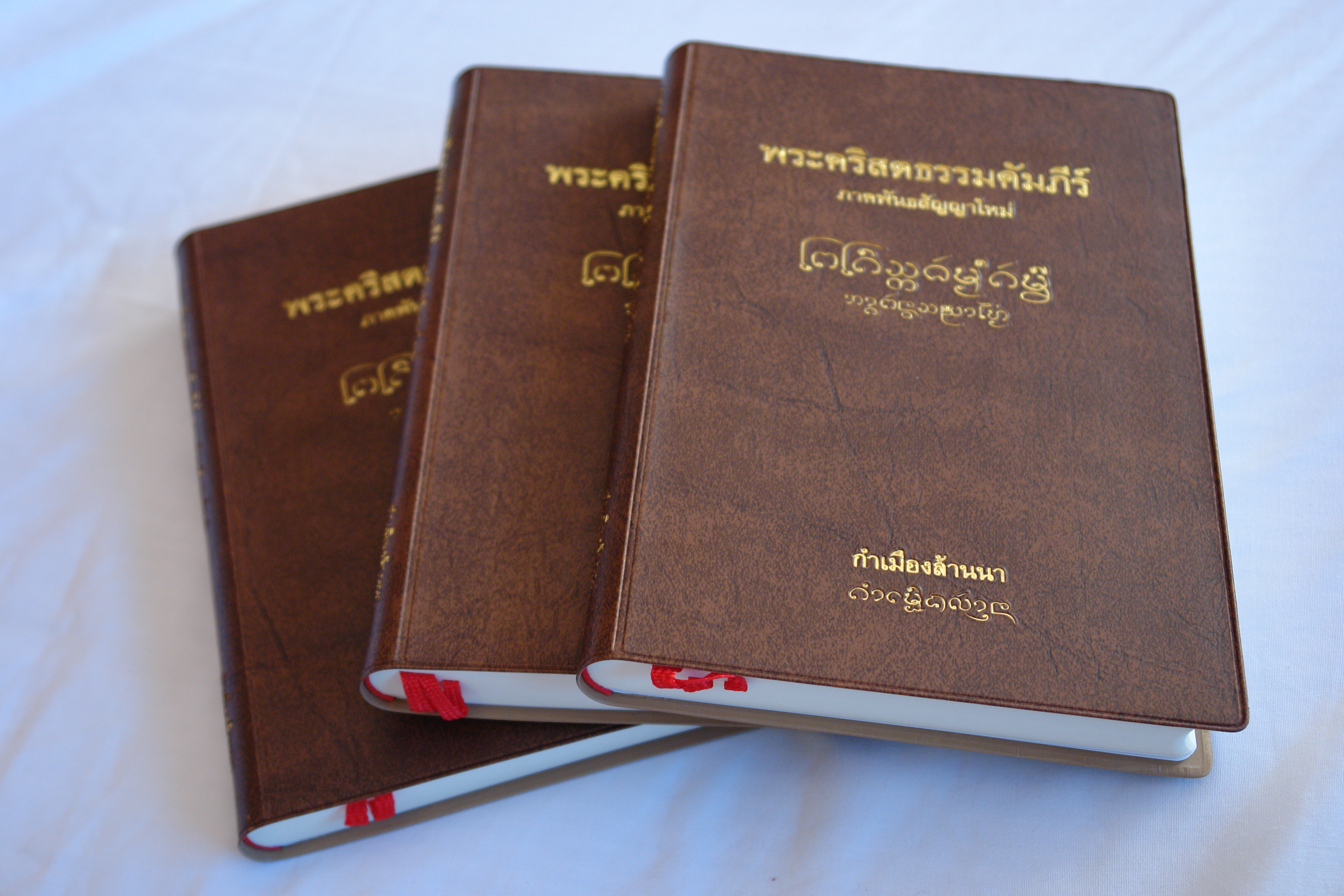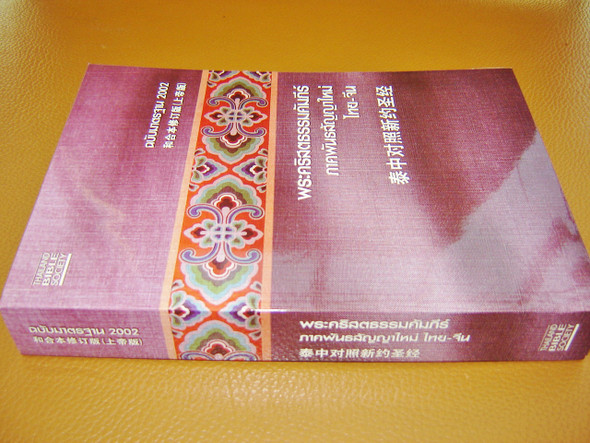Description
New Testament in Northern Thai Language / Thai Parallel Lanna Script
Product Features
- Title: New Testament in Northern Thai Language
- Script: Thai Parallel Lanna Script / Thai Tham Script
- Region: Thailand, specifically the Northern region known as Kam Mueang
- Format: Likely paperback or hardcover
- Language: Northern Thai
Summary
The New Testament in Northern Thai Language with Thai Parallel Lanna Script and Thai Tham Script is a significant religious text for the Northern Thai community. This edition provides the New Testament scriptures in the traditional scripts of the region, making it accessible to those who are familiar with either the Lanna or Tham scripts. The Northern Thai language, also known as Kam Mueang, is spoken by millions in Northern Thailand, and this text serves as a vital link to the Christian faith for this linguistic group.
Interesting
The Lanna script, also known as Tai Tham, has a rich history in Northern Thailand and is used for writing the Northern Thai language. It is closely related to other scripts used for Tai languages and has been historically significant for the transmission of Buddhist texts. The use of this script for the New Testament reflects a respect for cultural heritage and provides a bridge between ancient traditions and contemporary religious practice.
Reviews
Specific reviews for this edition of the New Testament in Northern Thai were not found, but the importance of having religious texts in one's native language is well-documented. Such editions are crucial for personal study, liturgical use, and the preservation of linguistic and cultural identity.We invite you to write a review and share your experience with this New Testament and our service.

Vinyl Bound
2017 Print
Wycliffe Thai Foundation
Wycliffe Bible Translators
ISBN 9786169139621 / 978-6169139621
Only 1,050 Copies in Print
906 Pages
WHY A PARALLEL VERSION?
Currently, different scripts are used to write Northern Thai. Northern Thai is traditionally written with the Tai Tham script, which in Northern Thai is called tua mueang (ᨲᩫ᩠ᩅᨾᩮᩥ᩠ᩋᨦ ตั๋วเมือง /tǔa.mɯ̄aŋ/) or tua tham (ᨲᩫ᩠ᩅᨵᩢᨾ᩠ᨾ᩺ ตั๋วธัมม์ /tǔa.tʰām/). However, native speakers are presently illiterate in the traditional script; therefore, they instead use the Thai script to write the language. In Laos, the Lao script is commonly used to write Northern Thai.

The Tai Tham script, Lanna script (Thai: อักษรธรรมล้านนา) or Tua Mueang (Lanna: ᨲ᩠ᩅᩫᨾᩮᩥᩬᨦ, Northern Thai pronunciation: [tǔa.mɯ̄aŋ] ![]() listen, Tai Lü: ᨲᩫ᩠ᩅᨵᨾ᩠ᨾ᩼ , Tham, "scripture"), is used for three living languages: Northern Thai (that is, Kham Mueang), Tai Lü and Khün. In addition, the Lanna script is used for Lao Tham (or old Lao) and other dialect variants in Buddhist palm leaves and notebooks. The script is also known as Tham or Yuan script.
listen, Tai Lü: ᨲᩫ᩠ᩅᨵᨾ᩠ᨾ᩼ , Tham, "scripture"), is used for three living languages: Northern Thai (that is, Kham Mueang), Tai Lü and Khün. In addition, the Lanna script is used for Lao Tham (or old Lao) and other dialect variants in Buddhist palm leaves and notebooks. The script is also known as Tham or Yuan script.
It is a Tai language closely related to Lao. Northern Thai has approximately six million speakers, most of whom live in Thailand, with a few thousand in northwestern Laos.
Speakers of this language generally consider the name "Tai Yuan" to be pejorative. They generally call themselves khon mueang (คนเมือง, [xon˧ mɯːəŋ˧]), Lanna, or Northern Thai. The language is generally known by one of these terms or as Phayap.
The term Yuan is still sometimes used for Northern Thai's distinctive Tai Tham alphabet, which is closely related to the old Tai Lue alphabet and the Lao religious alphabets. The use of the tua mueang, as the traditional alphabet is known, is now largely limited to Buddhist temples, where many old sermon manuscripts are still in active use. There is no active production of literature in the traditional alphabet. The modern spoken form is called Kam Muang. There is a resurgence of interest in writing it in the traditional way, but the modern pronunciation differs from that prescribed in spelling rules.[3]
Most linguists consider Northern Thai to be more closely related to Thai and the other Chiang Saeng languages than to Lao and the Lao–Phutai languages, but the distinction is never easy to make, as the languages form a continuum with few sharp dividing lines.
The Northern Thai language is a close relative of Thai and member of the Chiang Saeng language family. It is spoken by nearly 6,000,000 people in Northern Thailand and several thousand in Laos of whom few are literate in Lanna script. The script is still read by older monks. Northern Thai has six linguistic tones and Thai only five, making transcription into the Thai alphabet problematic. There is some resurgent interest in the script among younger people, but an added complication is that the modern spoken form, called Kammuang, differs in pronunciation from the older form. There are 670,000 speakers of Tai Lü of whom those born before 1950 are literate in Tham, also known as Old Tai Lue.[citation needed] The script has also continued to be taught in the monasteries. The New Tai Lue script is derived from Tham. There are 120,000 speakers of Khün for which Lanna is the only script.
| Northern Thai | |
|---|---|
คำเมือง |
|
| Pronunciation | [kam˧ mɯːəŋ˧], ( |
| Region | Northern Thailand |
| Ethnicity | Northern Thai people |
|
Native speakers
|
(6 million cited 1983)[1] |
|
Language family
|
Tai–Kadai
|
|
Writing system
|
Tai Tham alphabet (standard), Thai alphabet (de facto since early 20th century) |
| Official status | |
|
Recognised minority
language in |
Thailand
|
| Language codes | |
| ISO 639-3 | nod |
| Glottolog | nort2740 |
| Tai Tham | |
|---|---|
 |
|
| Type |
Abugida
|
| Languages | Northern Thai, Tai Lü, Khün |
|
Time period
|
c. 1300–present |
|
Parent systems
|
Proto-Sinaitic alphabet
|
|
Child systems
|
New Tai Lue |
| Direction | Left-to-right |
| ISO 15924 | Lana, 351 |
|
Unicode alias
|
Tai Tham |
|
Unicode range
|
U+1A20–U+1AAF |





















































![Thai New Testament / Thai NT R273/277 Thailand [Paperback] by Bible Society Thai New Testament / Thai NT R273/277 Thailand [Paperback] by Bible Society](https://cdn11.bigcommerce.com/s-62bdpkt7pb/images/stencil/590x590/products/1446/17115/1%2520%25281%2529__95688.1462823573.JPG?c=2)
![Thai New Testament / Thai NT R273/277 Thailand [Paperback] by Bible Society Thai New Testament / Thai NT R273/277 Thailand [Paperback] by Bible Society](https://cdn11.bigcommerce.com/s-62bdpkt7pb/images/stencil/590x590/products/1446/17130/1%2520%25282%2529__40108.1462823573.JPG?c=2)







